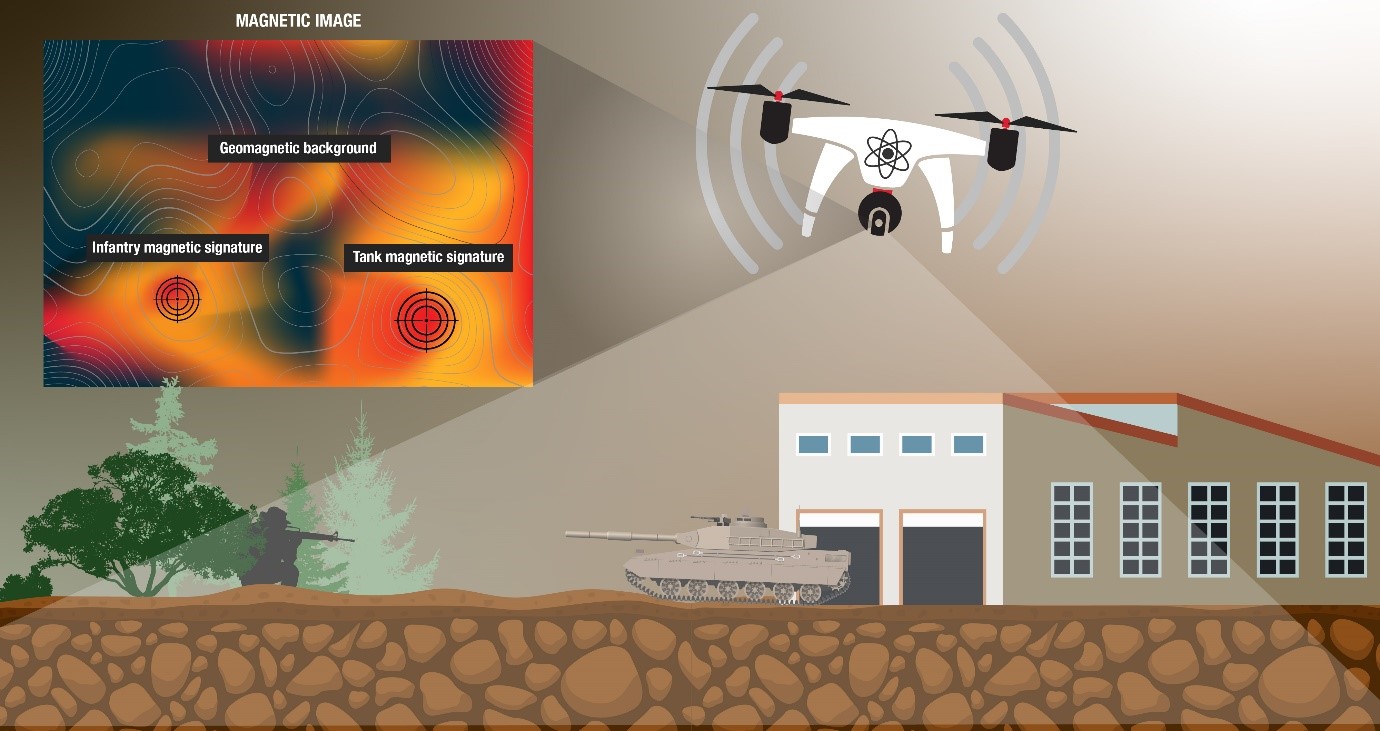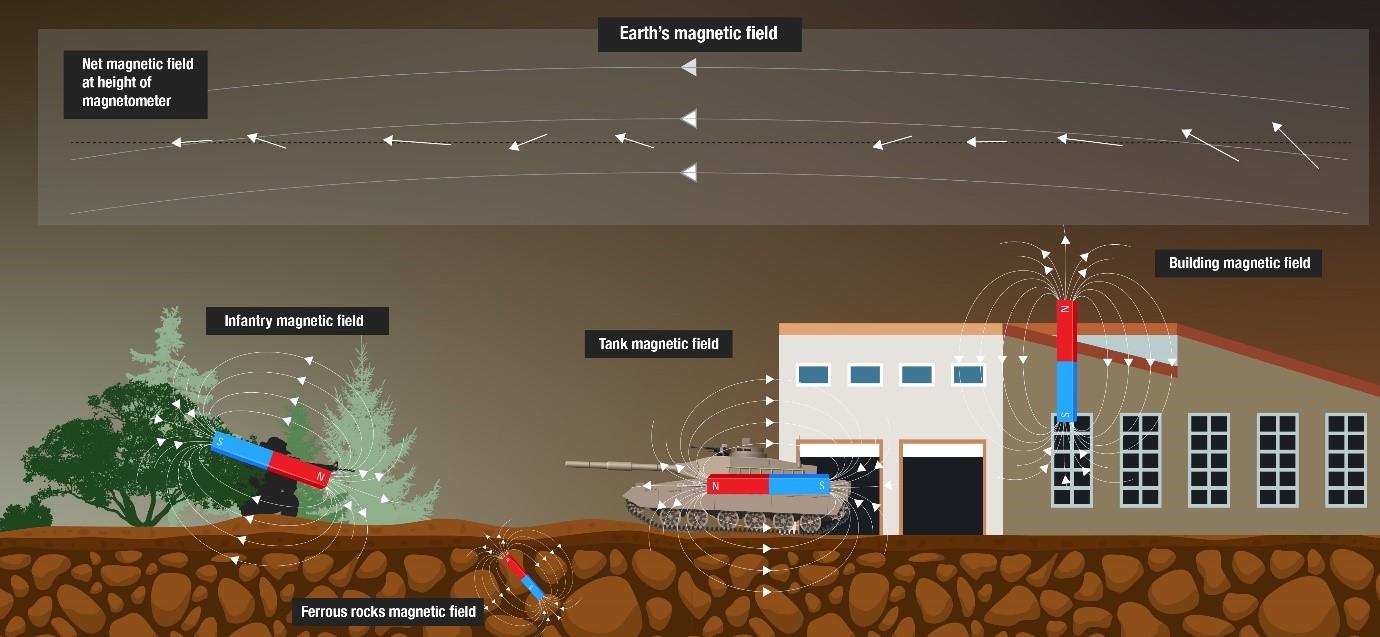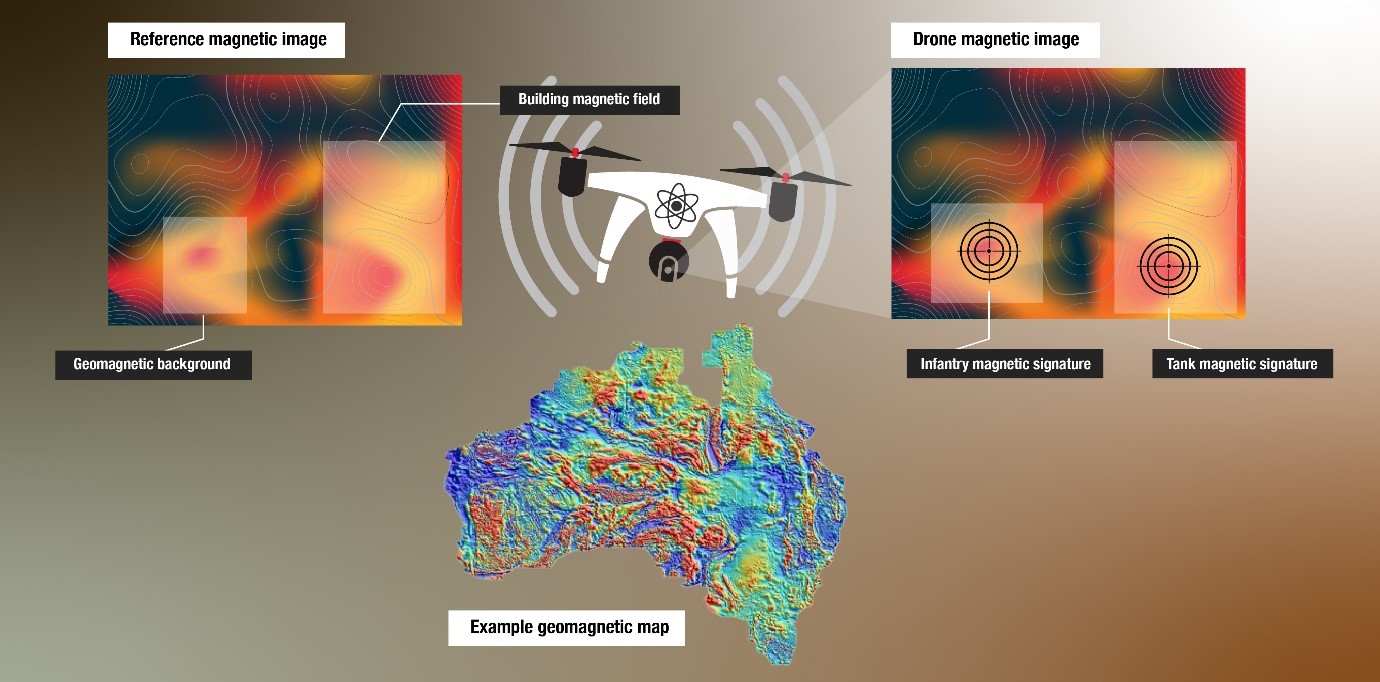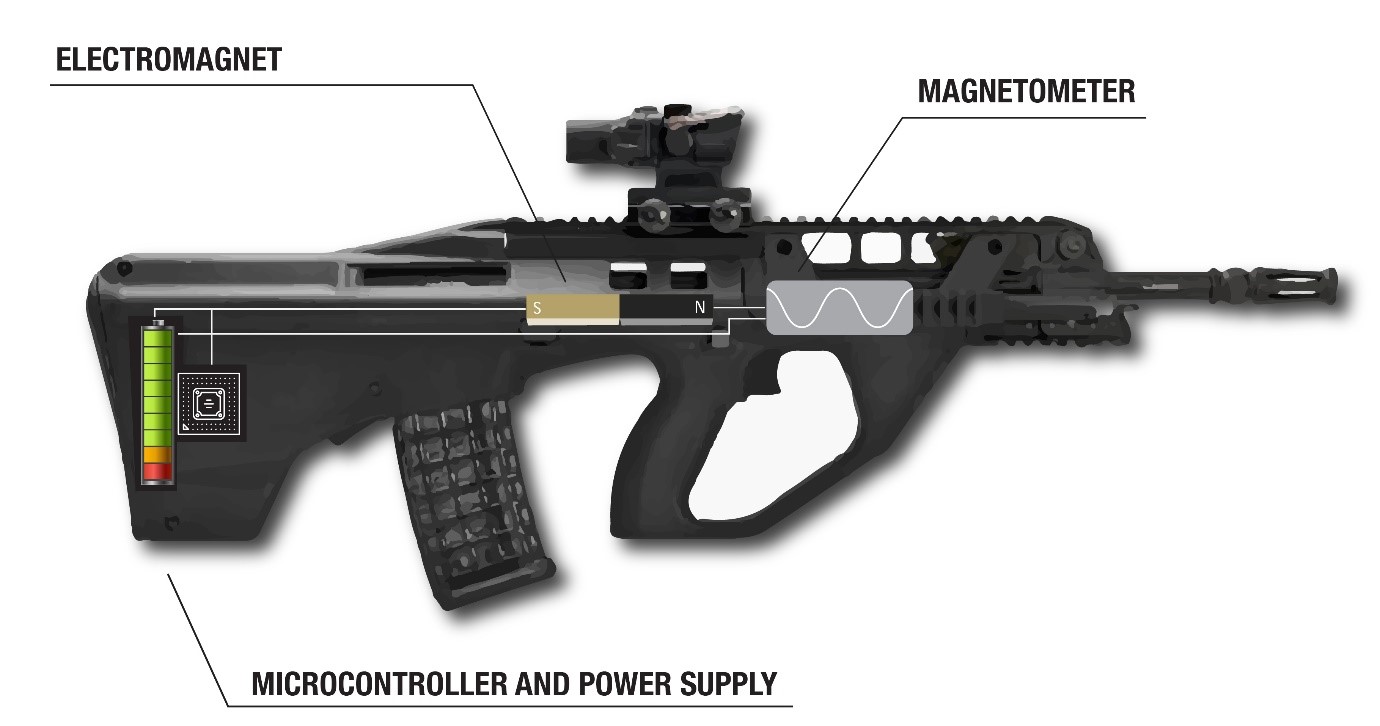The Robotic and Autonomous Systems Implementation and Coordination Office (RICO) of the Future Land Warfare Branch of AHQ is calling for Army teams to invent ingenious countermeasures to the looming threat of detection by ultra-precise quantum sensors.
The threat
The Quantum Technology Challenge 2021 (QTC21) revealed the potential threat of adversaries using ultra-precise quantum sensors to locate our soldiers by the magnetic signatures of their equipment, vehicles, weapons etc (i.e. anything containing sufficient amounts of iron).
Specifically, QTC21 saw teams from Australia’s quantum technology industry employ their prototype quantum magnetometers (some of which were similar in size as a mobile phone) to perform a range of demonstrations, including the detection of rifle-sized iron rods passing through sewer-like tunnels and vehicle-sized objects passing through deep reinforced tunnels. See the video.
The detection of the magnetic signatures of such objects requires extreme sensitivity. Whilst existing ‘classical’ magnetometers possess such sensitivity, they tend to be large and fragile, and not compatible with mass employment in land operations.
The dramatic reductions in size, weight and power offered by quantum magnetometers raises the possibility that, for the first time, ultra-precise sensors could be used en mass across the full spectrum of surveillance platforms (e.g. portable ground-based arrays and vehicle/ UAV/ aircraft/ satellite mounted sensors) to locate and target land forces by their magnetic signatures.

Figure 1: Concept diagram of detection and targeting by quantum sensors
This poses a significant threat and there is a need to understand how the magnetic signatures of land forces can be reduced or concealed from such sensors. This is especially difficult as land platforms, weapons and materiel are numerous and, diverse and complex in their shape and function. Thus, new countermeasures that are scalable and adaptable are required.
The time to develop such countermeasures is short, based upon the estimated work that is required to refine, miniaturise and harden the prototypes demonstrated at QTC21.
The response
Having identified the threat and its timeline, RICO is seeking to identify innovative countermeasures to the emerging quantum magnetometer technologies in order to both ameliorate the threat of adversarial sensors and to harden our own sensors from adversarial countermeasures.
RICO is pursuing the discovery of countermeasures through two parallel activities:
- Quantum Next Generation 2021 (QNG21) – for teams of Australia’s next generation of quantum industry and research talent
- Quantum Camouflage Challenge 2021 (QCamo21) – for teams of Army’s innovative soldiers and officers.
In each activity, teams will first develop their countermeasure idea and pitch it at the combined Pitchfest that is being held on 09 December 2021 in conjunction with the Australian Institute of Physics Summer Meeting. The pitches will be evaluated by a panel of experts drawn from across Defence. The top-ranked teams in both activities will then be invited to further develop their countermeasures and demonstrate them as special entrants into Quantum Technology Challenge 2022, which will be held at the Adelaide Convention Centre on 11 August 2022.
The call
If you are a current Army member who is interested in technology and innovation, and/ or is good at ‘MacGyver-ing’ solutions to complex problems, then register your interest in QCamo21 below. You don’t need to already have a team, there will be opportunities to connect with similarly-minded members and form a team later. All you need to participate is an active ADELE account.
You also don’t need to know any quantum physics! All you need to know is the basics of magnetism: permanent magnets, electromagnets and magnetic fields. See ‘Getting started’ below to get some initial ideas.
Registrations of interest will close on 22 October 21.
Following the Workshop, you will be required to form and register your team via ADELE by 03 November 21.
Your team’s immediate objective will be to prepare your pitch for the Pitchfest on 09 December 2021 at QNG21. The purpose of your pitch is to convince the evaluation panel that your idea is a suitable and feasible countermeasure, and that your team will be able to develop a simple prototype or simulation that demonstrates the key principles of your countermeasure at QTC22.
Your pitch consists of a 10 minute verbal presentation supported by slides and other aids (to be discussed with organisers), followed by 3 minutes of question and answer with the evaluation panel. Pitches will be delivered remotely using a suitable video conferencing platform (to be determined) and should cover:
- Countermeasure solution. Briefly describe your interpretation of the problem and your solution, including key concepts, techniques and methods.
- QTC22 demonstration proposal. Describe what you plan to demonstrate at QTC22 and how this will prove the key principles of your solution.
- Team summary. Describe how the experience, expertise, structure and resources of your team combine to give confidence that you can execute your plan and deliver QTC22.
- Project plan. Briefly describe how you plan to further develop your solution and execute your demonstration at QTC22.
To help you prepare your pitch, your team will have a least two sessions with expert Army coaches.
The top-ranked team(s) at the Pitchfest will be invited as special entrants to QTC22. If your team is invited, then you will receive further coaching sessions and resources to develop your ideas in the first half of 2022. Resources may include rapid-prototype training, facility access and materials at the Army MakerSpaces.
Note that your participation in QCamo21 should not to interfere with your normal duties unless your supervisor agrees that you can allocate time as part of your Professional Military Education. Any work release is to be negotiated and approved within local chains of command.
The reward
All participants will be rewarded by coaching sessions with Army personnel, free registration to the AIP Summer Meeting, and professional filming and publication of their pitch. A great way to build your knowledge and networks, and demonstrate your technology and innovation skills within the emerging technology and accelerated warfare.
In addition to being invited and receiving support to further develop their ideas as a special entrant to QTC22, the top-ranked team(s) will also receive admission to the Army Robotics Expo 2022 and the Army Innovation Day 2022. It is a significant privilege to be invited to those events and a further chance to expand your knowledge, exposure to emerging technology and Army initiatives to achieve an advantage in the future operating environment, as well as building networks in technology and innovation.
Getting started
You don’t need to know any quantum physics to be successful in QCamo21. All you need to know is the basics of magnetism: permanent magnets, electromagnets and magnetic fields. The following outlines the basics and gives you some ideas to get you started on the challenge.
The magnetic world
Recall your navigation training. There you learnt that the Earth has a magnetic field with field lines that run between the magnetic south and north poles. These poles are, to a good approximation, equivalent to the poles of a bar magnet. We use a compass to determine the direction of our travel with respect to the Earth’s magnetic field, which we can in turn reference to the directions of the grid lines on our maps.

Figure 2: Image of Earth’s magnetic field, its equivalence to a bar magnet and compasses indicating the direction of the field at different positions.
You were also warned in your navigation training that building, vehicles, weapons and other metallic objects or even local variations in the iron content of the ground may distort the Earth’s magnetic field, and give you a false compass reading. That is because those local objects are magnetic and produce their own magnetic field that ‘superimposes’ with the Earth’s magnetic field. This changes the size of the net local magnetic field as well as its direction: if the magnetic fields point in the same direction, then the net field is larger, whereas if they point in opposite directions, the net field is smaller.
See the example below that shows how local objects can be modelled by bar magnets of different strengths and how their fields interfere with the Earth’s field to produce the net local field.

Figure 3 - Image of scene with local objects, their equivalence to bar magnets, the magnetic fields they produce, and the net field at position of magnetometer.
The net local field is what a magnetometer will detect and image. Indeed, magnetometers have already been used to produce magnetic maps (see below). Primarily with the aim of discovering iron and other mineral deposits.
The presence of vehicles and other magnetic land materiel will appear as additional features on these magnetic maps. However, the scale and distribution of natural/ permanent features can vary greatly and on the similar scale as those produced by land materiel. So, in general, an adversary will only be able to detect a target if:
- its signature is clearly different to the natural/ permanent background, or
- they compare a new image with a reference image of the background, or
- the target moves during imaging.

Figure 4 – Upper: example of how targets may be identified by comparing a drone magnetic image to a reference magnetic map. Lower: Example geomagnetic map of Australia (courtesy of Geosciences Australia).
Quantum magnetometers 101
There are many types of quantum magnetometers. The magnetometers demonstrated at QTC21 were based upon atom vapour cells and atom defects in a diamond. A basic idea of how these devices work is that they measure magnetic fields by how they change the quantum state of the atoms within the sensor. The change is detected through the application of microwave and/ or light pulses. The pulses and detection signals are controlled and interpreted using electronics, which also link to computers, networks and the user. See the Land Power Forum for more information.
Importantly, the sensitivity of the quantum magnetometers is inversely related to the instability of the microwave/ light pulses and the sensor’s temperature. Thus, the key to the success of quantum magnetometers is the miniaturisation, stabilisation and shielding of their control systems.
Scope of countermeasure scenarios
There is an incredibly diverse range of scenarios where quantum magnetometers may be used to locate our land forces. Countermeasures are sought for as many as possible. Obviously, countermeasures that are effective in more scenarios will be preferred.
The range of scenarios can be characterised by the following dimensions:
- Magnetic terrain. Ranging from magnetically-trivial rural terrain to magnetically-complex urban terrain.
- Magnetic object size, distribution and range. Ranging from objects with small magnetic signatures (i.e. small arms) to large signatures (i.e. tanks) that are concentrated or dispersed, and at different distances from the adversary magnetometer (i.e. from a few metres away on the ground above to a high-altitude surveillance aircraft).
- Adversarial magnetometer deployment. Ranging from arrays of ground-based static sensors, to swarms of low altitude drones equipped with sensors, to systematic scanning by sensors on higher altitude UAS/ aircraft.
Basic countermeasure concepts
The five distinct basic countermeasure ideas that commonly known so far are:
- Reduce. Decrease the magnetic signatures of land materiel by using alternate materials, adding magnetic shielding or demagnetising.
- Decoy. Deploy magnets or magnetised objects in order to obscure which magnetic features detected by the adversarial magnetometers are genuine land forces and not decoys – create and then hide in the magnetic noise.
- Conceal. Use magnetic maps or our own magnetometers to work out where to position our forces so that they are indistinguishable from the magnetic background – hide in the natural noise.
- Cloak. Deploy active systems of magnetometers and electromagnets with our forces to null their magnetic signatures. The local magnetometer can measure the magnetic field generated by an object, which can then be used to manipulate a local electromagnet to generate a field that cancels the magnetic field of the object.
- Jam. Target the adversarial quantum magnetometers with electromagnetic radiation in order to disable or reduce their sensitivity through destabilisation.
Each have different advantages and disadvantages. Nevertheless, they might be a good start for you. Perhaps you can work out an effective, feasible and scalable way to implement one of them. For example, the rifle cloaking device that could be built in an Army MakerSpace below.

Figure 5 – Schematic of a prototype magnetic cloaking device for a rifle.
Or, perhaps you will come up with a completely different concept and means to implement.
Be bold, and good luck!









